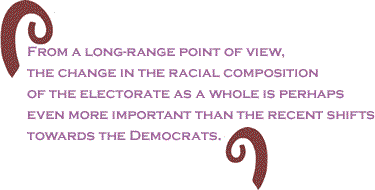
|
|||||||||||||||||||||||

|
||||||||||||||||||||||||||

Custom Search
|
||||||||||||||||||||||||||
 |
||||||||||||||||||||||||||
Barack Obama’s victory is indeed an historic breakthrough for U.S. politics. In a country that enforced a system of legalized racism until just 40 years ago, and that was founded on white supremacy, black slavery and Native genocide, the election of the first black president is cause for jubilation. The significance of Obama’s victory is accentuated by the fact that not only is he an outstanding individual with liberal politics and a community organizer’s instincts, but he is also leading a potentially historic realignment of U.S. politics. Such realignment could not come at a better time. Beset by a deep economic crisis, now is the time for progressive structural changes to the international and national socio-economic landscape. But such changes will be impossible without enormous political strength. Whether President Obama can help orchestrate a turnaround of the economic crisis now facing the country, indeed the world, will be revealed in the coming years. But he has already made a major contribution to changing the pattern of U.S. politics, a pattern that was set by slavery and enabled conservative Republicans to dominate the presidency for the last forty years.
However, the development of a mass progressive movement with its own agenda will be critical to consolidating that realignment, and to winning systemic change in the years to come. The Color of Election 2008 The magnitude of Obama’s victory has led to much hyperbole about the end of racism and the advent of a colorblind society. This notion deserves closer examination lest Obama’s victory become an obstacle, rather than an opening, to future racial progress. Much of the press has focused on celebrating the willingness of many whites to elect a black president. But just how colorblind is the U.S. electorate? Despite the fact that the Republicans had failed miserably, even on their own terms, and run the country virtually into the ground, whites still voted for McCain by 55 to 43. In stark contrast, blacks voted for Obama by 95 to 4, Latinos went for Obama by 66 to 32 and Asians backed Obama by 61 to 35. (1) In 2008, the white vote was virtually identical to election 2000 and continued to exert a strong conservative pull on the electorate while the votes of peoples of color and young people of all races headed powerfully in a more progressive direction.
The color lines, in life and politics, are alive and well. Indeed, peoples of color made the biggest shifts in their voting between 2004 and 2008. It was they who proved decisive in Obama’s victory. Left to white voters, John McCain would have won a landslide twelve-point victory. African Americans voted for Obama by an astonishing 95 to 4, a fourteen-point swing for the Democrats compared to 2004. (2) Many a pundit has dismissed this result as a knee-jerk racial solidarity vote for Obama. How soon they forget that the majority of black voters favored Hillary Clinton for the many months leading up to the Iowa primary. Much of the mainstream media declared that Latinos were too racist to vote for Obama. They pointed to the large Latino primary vote for Clinton as “proof.” Latinos resoundingly put the lie to these cynics by voting for Obama by 66 to 32, a huge sixteen-point swing to the Democrats compared to 2004. Even a 58 percent majority of Cubans in Florida, traditionally solidly Republican, went for Obama. Latinas led the way toward Obama, casting 68 percent of their votes for him and only 30 percent for McCain. Latino voters under 30 went for Obama by 76 to 24, perhaps indicating the direction of future Latino voting patterns. Asians swung Democratic by fourteen points over 2004, voting for Obama 61 to 35. The political trajectory of Asian voters has been striking. In 1992, Bill Clinton received only 31 percent of the Asian vote. Since then Asians have steadily moved Democratic, reaching a highpoint this year. So much for the pundits who believed that Latinos and Asians would never unite behind black leadership. These results amount to a massive progressive motion by peoples of color. Meanwhile the white vote swung toward Obama and the Democrats by five points compared to 2004. White voters under 30 were the only age group among whites to favor Obama. They voted for him by 54 to 44. All other whites voted for McCain by about 57 to 41. The most anemic swing was made by white women, who voted for McCain by 53 to 46, moving a mere four points toward the Democrats, This was particularly disappointing in light of their ten point swing to Bush from 2000 to 2004, a change that accounted for Bush’s victory in that year.
White men favored McCain by a bigger margin, 57 to 41, but this represented a sizable nine-point swing to the Democrats compared to 2004 when they voted for Bush overwhelmingly, 62 to 37. Overall, Obama carried the white vote in only 18 states, mostly in the Northeast and the West Coast. The Changing Color of the Electorate From a long-range point of view, the change in the racial composition of the electorate as a whole is perhaps even more important than the recent shifts towards the Democrats. In 1976 whites constituted 90 percent of the vote; in 2000 they still accounted for 81 percent. This year the white share of the vote fell to 74 percent, quite a dramatic change in a short time. Just as surprising, the main group increasing its share of the electorate is not Latinos, but African Americans. Blacks constituted thirty percent of all new voters in 2004, and an even greater mobilization this year brought them to 13 percent of the overall vote, a thirty percent increase over 2000. The sheer numbers of Latino and Asian voters have risen significantly over the same period, but their percentage share of the overall vote is virtually unchanged since 2000: nine percent for Latinos and two percent for Asians. (3) Surprisingly, the percentage of the electorate that is under thirty years of age, regardless of color, also remained stable, at 17-18 percent. However, these voters increased their Democratic vote by 12 points compared to 2004, voting for Obama by 66 to 32. Young voters were also the main corps of Obama field organizers and their energy gave the campaign much of its movement-like quality. Historic Realignment? The true maverick in the 2008 campaign was not McCain who pursued the same old reactionary Republican Southern Strategy, but Obama whose bold strategy of fighting for the South and the Southwest, indeed all fifty states, ran counter to all previous electoral “common sense.” His success was both astonishing and history making. He won the southwestern states of Nevada, Colorado and New Mexico, and the former Confederate slave states of Virginia, North Carolina and Florida, as well as former slave states Maryland and Delaware. The Latino vote was decisive for Obama in Nevada, New Mexico, Florida and Colorado. In all, nine states switched from red to blue from 2004 to 2008: Virginia, North Carolina, New Mexico, Colorado, Florida, Indiana, Ohio, New Hampshire and Iowa. Obama lost Missouri by the narrowest of margins. The historic nature of these victories is brought into sharp relief by the accompanying maps.
Map of 2004 Election Results The first is the map of slave versus free states and territories just prior to the Civil War. The other is the electoral map of the 2004 election. Depressingly, they are almost identical: the former slave areas are almost universally Republican and the former free areas, with a couple of exceptions, are Democratic. Almost 150 years after the abolition of slavery, the political patterns wrought by the “peculiar institution” still shape U.S. politics. Barack Obama’s campaign may mark the beginning of the end of this historic pattern, with tremendous implications for the future of U.S. politics. The main window into this change is the Electoral College. Electoral College: a Pillar of Racism It is not so surprising that slavery set the pattern of U.S. politics if one knows that the Electoral College itself was a product of slavery. The Founding Fathers, led by slaveholders such as George Washington, Thomas Jefferson, James Madison and James Monroe, invented the Electoral College out of thin air to serve their interests. They codified the notorious idea that slaves were non-humans, and thus deserving of no constitutional or human rights. The one exception to this rule was the stipulation that slaves were to be counted as three-fifths of a person, solely for the purpose of determining how many congressional representatives each state would be allotted. The three-fifths rule vastly increased the slave power in the House of Representatives and therefore the Congress.
The Electoral College, in which each state receives a number of Electors equal to their congressional delegation, was invented as the institutional means to transfer that same pro-slavery congressional allocation to determining the presidency. Slaveholders held the presidency for 50 of the 72 years before Abraham Lincoln, who was elected in 1860, became the first U.S. president to oppose the expansion of slavery. The South, used to wielding political power through the selective enumeration of slaves, promptly seceded. Since the end of slavery the Electoral College has remained a racist and conservative instrument. It has given the Republicans a running head start to win the presidency ever since reactionary Southerners switched en masse from the Democratic Party to the Republican Party in protest of the 1960s civil rights legislation. As then-Republican strategist Kevin Phillips put it in 1970, “The more Negroes who register as Democrats in the South, the sooner the Negrophobe whites will quit the Democrats and become Republicans. That's where the votes are.” Based on that switch, the Republicans adopted the notorious Southern Strategy that has enabled them to dominate the presidency for the last forty years. The Republicans learned to skillfully fashion a winning combination of the solidly Republican white southern voters with conservative and moderate whites in the Midwest and Southwest, through barely coded racist appeals. The Southern Strategy has been the glue with which the Republican Party has united powerful corporate capitalists to conservative white workers, farmers, gun aficionados, small business owners and suburban homeowners. Negating the Southern Black Vote The racial bias embedded in the Electoral College system is the structural basis of the Republican’s Southern Strategy. The winner-take-all Electoral College system ensures, even requires, that about half of all voters of color be marginalized or totally ignored. (4) About 53 percent of all blacks live in the southern states, and in 2000 and 2004 they voted about 90 percent Democratic. However, in those elections white Republicans out-voted them in every Southern state and every border state except Maryland. As a result, every single southern Electoral College vote was awarded to Bush. While whites voted 54-42 for Bush nationally in 2000, southern whites gave him over 70 percent of their votes in both 2000 and 2004. They thus completely erased the massive Southern black vote for the Democrats in that region. The Electoral College result was the same as if blacks, and other Democrats, in the South had not voted at all. Similarly negated were the votes of millions of Native American and Latino voters who live in overwhelmingly white Republican states like Arizona, Nevada, Oklahoma, Utah, the Dakotas, Montana and Texas. Further, the peoples of Puerto Rico, the U.S. Virgin Islands, American Samoa and Guam, territories ruled by the U.S., get no Electoral College votes at all. The tyranny of the white, conservative majority prevailed. Compounding the reactionary and pro-Republican bias of the Electoral College, the system gives as much as three times as much weight to the mainly conservative and white Republicans in the rural states compared to states with large, racially diverse and majority Democratic populations. For example, Wyoming has a little more than 240,000 voters and has three Electoral College votes: one for every 80,000 or so voters. By comparison large population states like California have about one Electoral College vote for every 220,000 voters. Thus, the Electoral College system violates the principle of one person, one vote, drastically undermines the impact of the black vote and gives the Republicans a major advantage in presidential contests. Its abolition should be a key part of the progressive agenda. Final Thoughts Although the political dynamics of each of the nine states that turned from red to blue in 2008 need to be examined closely in their own right, it is likely that a minimum of three or four will move decisively into the Democratic column. A number of others that swung Democratic in 2008 have moved from being solidly red states to battleground states. The solid Republican South and Southwest may be a thing of the past. In the wake of Obama’s hard-won victories, the Democrats have no excuse for essentially conceding these regions, as they have done for decades. This will qualitatively shift the Electoral College math. Since 1968 the Electoral College has clearly favored the Republicans and the Democrats had to pull off an upset to win. Indeed, Bill Clinton won only because of the third party candidacy of Ross Perot. In the future, it may be that the Electoral College math will favor the Democrats, and that the Republicans can only win by staging an upset. Just as important, for the first time in U.S. history the two political parties clearly represent the two broad wings of U.S. politics. At the national level, the southern reactionaries no longer hold the Democratic Party hostage. This augurs well for the possibility that an Obama presidency may be able to gather the political strength to undertake a major restructuring of the economy in favor of working people and peoples of color in general, and to reorganize our foreign policy in a positive direction. However, there is still a major political element missing from the political equation: a powerful independent peoples’ movement. In the 1930s the union movement, and especially the newly formed, radical CIO, was key to the New Deal. In the 1960s the civil rights movement was the driving force of the War on Poverty. Herein lies the principal task of progressives in the coming period: to forge powerful independent, mass movements and organizations that can help shape the Obama coalition in a positive way. Our relative success or failure at this task may determine the future of the U.S. and the world every bit as much as President Obama himself. BlackCommentator.com Guest Commentator, Bob Wing is a writer and organizer in South Los Angeles, and former editor of ColorLines magazine and War Times newspaper. Click here to contact Mr. Wing. ----------------------------------------------------- Footnotes 1. Unless otherwise noted all voting figures are drawn from the National Exit Polls for 2000, 2004 and 2008, as reported by CNN. 2. I calculate the “swing” or “change” in the vote in the traditional but rather confusing manner as the change in the vote differential. For example, in 2004 blacks voted Democratic by 88 to 11, a 77 point differential. In 2008, they voted Democratic by 95 to 4, a 91 point differential. The vote differential thus changed from 77 points to 91 points, so I report a 14-point “swing” or “change.” 3. No national exit poll numbers are available about Arab or Native American voters for any year. 4. Only Nebraska and Maine allocate their electoral votes more or less proportionate to the vote rather than on a statewide winner-take-all basis. |
||||||||||||||||||||||||||
Any BlackCommentator.com article may be re-printed so long as it is re-printed in its entirety and full credit given to the author and www.BlackCommentator.com. If the re-print is on the Internet we additionally request a link back to the original piece on our Website. Your comments are always welcome. eMail re-print notice
If you send us an eMail message we may publish all or part of it, unless you tell us it is not for publication. You may also request that we withhold your name. Thank you very much for your readership. |
||||||||||||||||||||||||||
| |
||||||||||||||||||||||||||
| February
12, 2009 Issue 311 |
|
| Executive Editor: Bill Fletcher, Jr. |
| Managing Editor: Nancy Littlefield |
| Publisher: Peter Gamble |
| Est. April 5, 2002 |
Printer Friendly Version
in resizeable plain
text format or pdf
format. |
| Frequently Asked Questions |
 |

|
 |
 |
 |
| |
| |












































